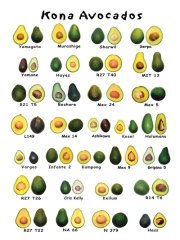|
Avocado, have one naked! They act as a nutrient booster and increase the body’s ability to absorb and use carotenoids, which are powerful antioxidants that help protect the body from damaging compounds. A good supply of antioxidants can help build up strength and resist stress. Naturally rich in omega -3, and really beneficial if you suffer from depression. It is an excellent source of lecithin, a type of fatty acid that helps break down fats in the diet. Are they fattening? Compared to other fruits they are high in calories, however, in comparison to other foods they are very low in calories.
The fat content is predominantly of the monounsaturated type. They contain the plant sterol beta-sitosterol which helps prevent cholesterol from being absorbed through the intestine. It also contains glutathione, an antioxidant that may offer protection against several cancers. Nutrients in Avocado Vitamins A,C,B1,B2,B6,E and K A good source of important minerals and vitamins. Always serve raw as they have a bitter taste when cooked. I love them and simply slice one and add to any savory dish I am eating. It goes particularly well with rice, pasta and salad. Have you tried it mashed on toast? It’s delicious. As I mentioned earlier, it is a fruit, being the reproductive part of the plant.
Due to its shape and rough skin it is commonly known as the alligator pear. There are three main types: –
Originally from Central America and first introduced to Europe by the conquistadors. I have often thought of trying to grow one myself, considering how many stones I recycle. Last summer I found one growing quite happily in my greenhouse. Here’s a saucy Salsa recipe you might like to try.
and here's how to put it all together
Mix all the ingredients together and leave to marinade for about 1 hour. Home page - from - Avocado
|






 A ripe avocado eaten scooped out of its skin with a spoon is such a great snack.
A ripe avocado eaten scooped out of its skin with a spoon is such a great snack.
